Avebury Stone Circle: Difference between revisions
m clean up, typos fixed: definitivly → definitively |
No edit summary |
||
| Line 11: | Line 11: | ||
==Location and environment== | ==Location and environment== | ||
*Location map: {{wmap|51.42861|-1.85417|zoom=14}} | |||
*Map: {{map|SU10266996}} | |||
[[File:Avebury henge and village UK.jpg|left|thumb|250px|Avebury circle and village]] | [[File:Avebury henge and village UK.jpg|left|thumb|250px|Avebury circle and village]] | ||
Avebury is respectively about 6 and 7 miles respectively from the modern towns of [[Marlborough]] and [[Calne]]. Avebury lies in an area of chalkland in the [[River Kennet|Upper Kennet Valley]], at the western end of the [[Berkshire Downs]]. The monument stands slightly above the local landscape, sitting on a low chalk ridge {{convert|160|m|ft|0|x}} above sea level; to the east are the [[Marlborough Downs]], an area of lowland hills. The site lies at the centre of a collection of Neolithic and early Bronze Age monuments and was inscribed as a [[World Heritage Site]] in a co-listing with the monuments at Stonehenge, 17 miles to the south, in 1986. It is now listed as part of the ''Stonehenge, Avebury and Associated Sites World Heritage Site''. The monuments are preserved as part of a Neolithic and Bronze Age landscape for the information they provide regarding prehistoric people's relationship with the landscape.<ref>{{cite web |url=http://whc.unesco.org/en/list/373 |title=Stonehenge, Avebury and Associated Sites |publisher=UNESCO |accessdate=26 July 2009}}</ref> | |||
Radiocarbon dating and analysis of pollen in buried soils have shown that the environment of lowland Britain changed around 4,250–4,000 BC. The change to a grassland environment from damp, heavy soils and expanses of dense forest was mostly brought about by farmers, probably through the use of slash and burn techniques. Environmental factors may also have made a contribution. Pollen is poorly preserved in the chalky soils found around Avebury, so the best evidence for the state of local environment at any time in the past comes from the study of the deposition of snail shells. Different species of snail live in specific habitats, so the presence of a certain species indicates what the area was like at a particular point in time.<ref>[[#Mal89|Malone 1989]]. pp. 31–32.</ref> The available evidence suggests that in the early Neolithic, Avebury and the surrounding hills were covered in dense oak woodland, and as the Neolithic progressed, the woodland around Avebury and the nearby monuments receded and was replaced by grassland.<ref>[[#Mal89|Malone 1989]]. pp. 31, 34–35.</ref> | Radiocarbon dating and analysis of pollen in buried soils have shown that the environment of lowland Britain changed around 4,250–4,000 BC. The change to a grassland environment from damp, heavy soils and expanses of dense forest was mostly brought about by farmers, probably through the use of slash and burn techniques. Environmental factors may also have made a contribution. Pollen is poorly preserved in the chalky soils found around Avebury, so the best evidence for the state of local environment at any time in the past comes from the study of the deposition of snail shells. Different species of snail live in specific habitats, so the presence of a certain species indicates what the area was like at a particular point in time.<ref>[[#Mal89|Malone 1989]]. pp. 31–32.</ref> The available evidence suggests that in the early Neolithic, Avebury and the surrounding hills were covered in dense oak woodland, and as the Neolithic progressed, the woodland around Avebury and the nearby monuments receded and was replaced by grassland.<ref>[[#Mal89|Malone 1989]]. pp. 31, 34–35.</ref> | ||
| Line 163: | Line 166: | ||
==Outside links== | ==Outside links== | ||
{{Commons|Avebury}} | {{Commons|Avebury}} | ||
*Location map: {{wmap|51.42861|-1.85417|zoom=14}} | |||
*Map: {{map|SU10266996}} | |||
*{{NT link|Avebury}} information at the National Trust | *{{NT link|Avebury}} information at the National Trust | ||
* [http://www.bbc.co.uk/wiltshire/content/articles/2008/08/08/day_out_avebury_marlborough_1982_film_feature.shtml ''Day Out: Avebury and Marlborough''] – A 30-minute BBC TV programme made in 1983 of a day spent exploring Avebury and Marlborough | * [http://www.bbc.co.uk/wiltshire/content/articles/2008/08/08/day_out_avebury_marlborough_1982_film_feature.shtml ''Day Out: Avebury and Marlborough''] – A 30-minute BBC TV programme made in 1983 of a day spent exploring Avebury and Marlborough | ||
| Line 208: | Line 213: | ||
*{{cite journal |last={{Smallcaps|Watson, Aaron}} |year=2001 |title=Composing Avebury |jstor=827904 |journal=World Archaeology |volume=33 (2) |pages=296–314 |ref=Wat01 |first1=A. |issue=2}} | *{{cite journal |last={{Smallcaps|Watson, Aaron}} |year=2001 |title=Composing Avebury |jstor=827904 |journal=World Archaeology |volume=33 (2) |pages=296–314 |ref=Wat01 |first1=A. |issue=2}} | ||
[[Category:National Trust properties in Wiltshire]] | [[Category:National Trust properties in Wiltshire]] | ||
[[Category:Stonehenge, Avebury and associated sites]] | |||
[[Category:World Heritage Sites in the United Kingdom]] | [[Category:World Heritage Sites in the United Kingdom]] | ||
[[Category:Stone circles in Wiltshire]] | [[Category:Stone circles in Wiltshire]] | ||
[[Category:Prehistoric Wiltshire]] | [[Category:Prehistoric Wiltshire]] | ||
Latest revision as of 12:44, 18 May 2016
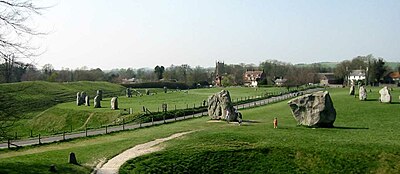
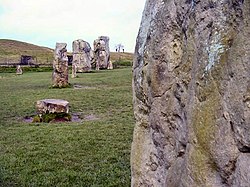
Avebury is a Neolithic henge monument containing three stone circles, around the village of Avebury in Wiltshire. Avebury contains the largest stone circle in Europe, and is one of the best known prehistoric sites in Britain.
The circles and banks of Avebury are part of a UNESCO World heritage Site. They are a popular tourist attraction and also draw in crowds of neopaganism devotees.
The monument was built around 2600 BC,[1] during the New Stone Age. It comprises a large bank and a ditch with a large outer stone circle and two separate smaller stone circles inside the centre of the monument. Its original purpose is unknown. The Avebury monument is a part of a larger prehistoric landscape containing several older monuments nearby, including West Kennet Long Barrow and Silbury Hill.
Avebury is owned and run by the National Trust. It has been designated a Scheduled Ancient Monument,[2] as well as a World Heritage Site, in the latter capacity being seen as a part of the wider prehistoric landscape of Wiltshire known as 'Stonehenge, Avebury and Associated Sites'.[3]
Location and environment
- Location map: 51.42861 -1.85417
- Map: SU10266996

Avebury is respectively about 6 and 7 miles respectively from the modern towns of Marlborough and Calne. Avebury lies in an area of chalkland in the Upper Kennet Valley, at the western end of the Berkshire Downs. The monument stands slightly above the local landscape, sitting on a low chalk ridge 525 feet above sea level; to the east are the Marlborough Downs, an area of lowland hills. The site lies at the centre of a collection of Neolithic and early Bronze Age monuments and was inscribed as a World Heritage Site in a co-listing with the monuments at Stonehenge, 17 miles to the south, in 1986. It is now listed as part of the Stonehenge, Avebury and Associated Sites World Heritage Site. The monuments are preserved as part of a Neolithic and Bronze Age landscape for the information they provide regarding prehistoric people's relationship with the landscape.[4]
Radiocarbon dating and analysis of pollen in buried soils have shown that the environment of lowland Britain changed around 4,250–4,000 BC. The change to a grassland environment from damp, heavy soils and expanses of dense forest was mostly brought about by farmers, probably through the use of slash and burn techniques. Environmental factors may also have made a contribution. Pollen is poorly preserved in the chalky soils found around Avebury, so the best evidence for the state of local environment at any time in the past comes from the study of the deposition of snail shells. Different species of snail live in specific habitats, so the presence of a certain species indicates what the area was like at a particular point in time.[5] The available evidence suggests that in the early Neolithic, Avebury and the surrounding hills were covered in dense oak woodland, and as the Neolithic progressed, the woodland around Avebury and the nearby monuments receded and was replaced by grassland.[6]
By the Iron Age, the site had been effectively abandoned, with some evidence of human activity on the site during the Roman occupation. During the Early Mediæval, a village first began to be built around the monument, which eventually extended into it. In the Late Mediæval and Early Modern periods, locals destroyed many of the standing stones around the henge, both for religious and practical reasons. The antiquarians John Aubrey and William Stukeley however took an interest in Avebury during the 17th century, and recorded much of the site before its destruction. Archaeological investigation followed in the 20th century, led primarily by Alexander Keiller, who oversaw a project of reconstructing much of the monument.
Background
The history of the site before the construction of the henge is uncertain, because little datable evidence has emerged from modern archaeological excavations.[7] Evidence of activity in the region before the 4th millennium BC is limited, suggesting that there was little human occupation.
Mesolithic
Of the Middle Stone Age, which lasted from circa 11,600 to 7800 Before Present, archaeologists have found evidence of hunter-gatherers' flint tools, dated between 7,000 and 4,000 BC,[8] including a densely scattered collection of worked flints found 300 yards west of Avebury, which has led archaeologists to believe that that particular spot was a flint working site occupied over a period of several weeks by a group of nomadic hunter-gatherers who had set up camp there.[9]
Mark Gillings and Joshua Pollard suggested the possibility that Avebury first gained some sort of ceremonial significance during the Late Mesolithic period, evidenced by a posthole near to the monument's southern entrance that would have once supported a large wooden post, though never dated nor definitively Mesolithic. They compared this with similar wooden posts that had been erected in southern Britain during the Mesolithic at Stonehenge and Hambledon Hill, both of which were sites that like Avebury saw the construction of large monuments much later in the Neolithic Age.[10]
Early Neolithic
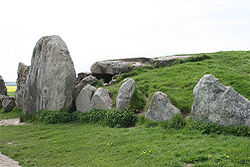 |
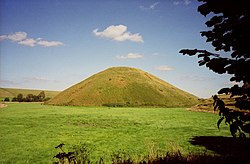 |
| The two monuments were built near Avebury several centuries before the stone circles | |
The New Stone Age was marked by the establishment of farming and thus of settled communities, and in this age came the stone monuments of Britain. Neolithic activity at Avebury is evidenced by flint, animal bones, and pottery such as Peterborough ware dating from the early 4th and 3rd millennia BC. Five distinct areas of Neolithic activity have been identified within 500 yards of Avebury; they include a scatter of flints along the line of the West Kennet Avenue – an avenue that connects Avebury with the Neolithic site of The Sanctuary. Pollard suggests that areas of activity in the Neolithic became important markers in the landscape.[11]
Late Neolithic
"After over a thousand years of early farming, a way of life based on ancestral tombs, forest clearance and settlement expansion came to an end. This was a time of important social changes."
During the Late Neolithic, British society underwent another series of major changes. Between 3500 and 3300 BC, these prehistoric Britons ceased their continual expansion and cultivation of wilderness and instead focused on settling and farming the most agriculturally productive areas of the island: Orkney, eastern Scotland, Anglesey, the upper Thames, Wessex, Essex, Yorkshire and the river valleys of the Wash.[13]
Late Neolithic Britons also appeared to have changed their religious beliefs, ceasing to construct the large chambered tombs that are widely thought to have been connected with ancestor veneration by archaeologists. Instead, they began the construction of large wooden or stone circles, with many hundreds being built across Britain and Ireland over a period of a thousand years.[14]
Construction
Avebury was constructed around 2600 BC, and was apparently used by the people living in the area for the next thousand years.[1] It was not designed as a single monument, but is the result of various projects that were undertaken at different times during late prehistory.[15]
Avebury was one of a group of monumental sites that were established in this region during the Neolithic. Its monuments comprise the henge and associated long barrows, stone circles, avenues, and a causewayed enclosure. These monument types are not exclusive to the Avebury area. For example, Stonehenge features the same kinds of monuments, and in Dorset there is a henge on the edge of Dorchester and a causewayed enclosure at nearby Maiden Castle.[16]
Archaeologist Mike Parker Pearson noted that the addition of the stones to the henge occurred at a similar date to the construction of Silbury Hill and the major building projects at Stonehenge and Durrington Walls. For this reason, he speculated that there may have been a "religious revival" at the time, which led to huge amounts of resources being expended on the construction of ceremonial monuments.[17]
Archaeologist Aaron Watson highlighted the possibility that by digging up earth and using it to construct the large banks, those Neolithic labourers constructing the Avebury monument symbolically saw themselves as turning the land "inside out", thereby creating a space that was "on a frontier between worlds above and beneath the ground."[18]
Henge
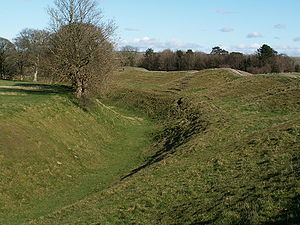
The Avebury monument consists of a large circular bank with an internal ditch. Although the ring is not perfectly circular, it has a diameter of about 460 yards across.[19] The only known comparable sites of similar date are only a quarter of the size of Avebury. The ditch alone was 69 feet wide and 36 feet deep, with a sample from its primary fill carbon dated to 3300–2630 BC (4300+/-90).[20]
The excavation of the bank has demonstrated that it has been enlarged, presumably using material dug from the ditch, so it could be assumed that the construction of the ditch could have started at the earlier date, although speculation puts it nearer the later date. The top of the bank is irregular, something archaeologist Caroline Malone suggested was because of the irregular nature of the work undertaken by excavators working on the adjacent sectors of the ditch.[21] Later archaeologists such as Aaron Watson, Mark Gillings and Joshua Pollard have however suggested that this was an original Neolithic feature of the henge's architecture.[22][23]
Outer Stone Circle
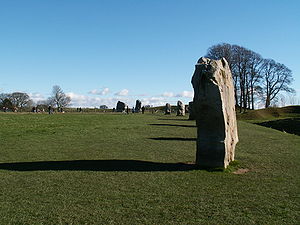
Within the henge is a great outer circle. This is one of Europe's largest stone circles,[24] with a diameter of 1,088 feet (332 m), Britain's largest stone circle.[25] It was either contemporary with, or built around four or five centuries after the earthworks. There were originally 98 sarsen standing stones, some weighing in excess of 40 tons. The stones varied in height from 12 feet to 14 feet, as exemplified at the north and south entrances. The fill from two of the stoneholes has been carbon dated to between 2900 and 2600 BC (3870+/-90, 4130+/-90)[26]
The two large stones at the Southern Entrance had an unusually smooth surface, likely due to having stone axes polished on them.[27]
Inner Stone Circles
Nearer the middle of the monument are two additional, separate stone circles. The northern inner ring is 322 feet (98 m) in diameter, but only two of its four standing stones remain upright. A cove cove of three stones stood in the middle, its entrance facing northeast. Taking experiments undertaken at the megalithic Ring of Brodgar in Orkney as a basis, the archaeologists Joshua Pollard, Mark Gillings and Aaron Watson believed that any sounds produced inside Avebury's Inner Circles would have created an echo as sound waves ricocheted off the standing stones.[27][28]
The southern inner ring was 354 feet in diameter before its destruction in the 18th century. The remaining sections of its arc now lie beneath the village buildings. A single large monolith, 18 feet high, stood in the centre along with an alignment of smaller stones.
The Avenue
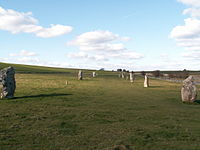
The West Kennet Avenue, an avenue of paired stones, leads from the southeastern entrance of the henge; and traces of a second, the Beckhampton Avenue, lead out from the western entrance.
The archaeologist Aaron Watson, taking a phenomenological viewpoint to the monument, believed that the way in which the Avenue had been constructed in juxtaposition to Avebury, the Sanctuary, Silbury Hill and West Kennet Long Barrow had been intentional, commenting that "the Avenue carefully orchestrated passage through the landscape which influenced how people could move and what they could see, emphasizing connections between places and maximizing the spectacle of moving between these monuments."[29]
Purpose

The purpose which Neolithic people had for the Avebury monument has remained elusive, although many archaeologists have postulated about its meaning and usage,[30] including theories about Neolithic rituals "to appease the malevolent powers of nature" or a representations of the centre of the world, or axis mundi, for those who constructed them,[22][31] and much else besides.
The human bones found by Gray point to some form of funerary purpose and have parallels in the disarticulated human bones often found at earlier causewayed enclosure sites. Ancestor worship on a huge scale could have been one of the purposes of the monument and would not necessarily have been mutually exclusive with any male/female ritual role.
The henge, although clearly forming an imposing boundary to the circle, has no defensive purpose as the ditch is on the inside. Being a henge and stone circle site, astronomical alignments are a common theory to explain the positioning of the stones at Avebury. The relationships between the causewayed enclosure, Avebury stone circles, and West Kennet Long Barrow to the south, has caused some to describe the area as a "ritual complex" – a site with many monuments of interlocking religious function.
Pseudoarchaeological theories
Various pseudoarchaeologists have interpreted Avebury and its neighbouring prehistoric monuments differently to those of their academic counterparts, informaed by wild imaginations rather than observation and science. These interpretations have been defined by professional archaeologist Aubrey Burl as being "more phony than factual", and in many cases "entirely untenable".[32] Such inaccurate ideas originated with William Stukeley in the late 17th century, who believed that Avebury had been built by the druids, priests of the Iron Age peoples of north-western Europe, although archaeologists since then have identified the monument as having been constructed two thousand years before the Iron Age, during the Neolithic.[33]
Following Stukeley, other writers produced inaccurate theories about how Avebury was built and by whom. The Reverend R. Warner, in his The Pagan Altar (1840) argued that both Avebury and Stonehenge were built by Phoenicians, an ancient seafaring people whom many Victorian Britons believed had first brought civilisation to the island.[34] James Fergusson disagreed, and in his Rude Stone Monuments in All Countries (1872) put forward the idea that the megalithic monument had been constructed in the Early Mediæval period to commemorate the final battle of King Arthur, and that Arthur's slain warriors had been buried there.[35] W S Blacket (1883) even suggested that the great megalithic monuments of southern Britain were built by Native Americans![36]
Later history
Iron Age and Roman periods
During the Iron Age, it appears that the Avebury monument had ceased to be used for its original purpose, and was instead largely ignored, with little archaeological evidence that many people visited the site at this time. Archaeologist Aubrey Burl believed that the Iron Age Britons living in the region would not have known when, why or by whom the monument had been constructed, perhaps having some vague understanding that it had been built by an earlier society or considering it to be the dwelling of a supernatural entity.[1]
In the Roman period, a newly constructed road passed this way.[1] Evidence of Roman visitors at the monument during this period has been found in the form of Roman-era pottery sherds uncovered from the ditch.[37]
Early Mediæval period
In 939, the earliest known written record of the monument was made in the form of a charter of King Athelstan which defined the boundaries of Overton, a parish adjacent to Avebury. In the following century, invading Danes may have attacked and burnt the village of Avebury, for the local prehistoric monument of Silbury Hill was fortified and used as a defensive position.
Late Mediæval period
By the Late Mediæval period, Avebury, being an evidently non-Christian monument, began to be associated with the Devil in the popular imagination of the locals. The largest stone at the southern entrance became known as the Devil's Chair, the three stones that once formed the Beckhampton Cove became known as the Devil's Quoits and the stones inside the North Circle became known as the Devil's Brand-Irons.[38] At some point in the early 14th century, villagers began to demolish the monument by pulling down the large standing stones and burying them in ready-dug pits at the side, presumably because they were seen as having been erected by the Devil and thereby being in opposition to the village's Christian beliefs.[39] Although it is unknown how this situation came about, archaeologist Aubrey Burl suggests that it might have been at the prompting of the local Christian priest, with the likely contenders being either Thomas Mayn (who served in the village from 1298 to 1319), or John de Hoby (who served from 1319 to 1324).[40]
During the toppling of the stones, one of them (which was 10 feet tall and weighed 13 tons), collapsed on top of one of the men pulling it down, fracturing his pelvis and breaking his neck, crushing him to death. His corpse was trapped in the hole that had been dug for the falling stone, and so the locals were unable to remove the body and offer him a Christian burial in a churchyard, as would have been customary at the time. When archaeologists excavated his body in 1938, they found that he had been carrying a leather pouch, in which was found three silver coins dated to around 1320–25, as well as a pair of iron scissors and a lancet. From these latter two items, the archaeologists surmised that he had probably been a travelling barber-surgeon who journeyed between market towns offering his services, and that he just happened to be at Avebury when the stone-felling was in progress.[41]
It appears that the death of the barber-surgeon prevented the locals from pulling down further stones, perhaps fearing that it had in some way been retribution for toppling them in the first place, enacted by a vengeful spirit or even the Devil himself.[42] The event appears to have left a significant influence on the minds' of the local villagers, for records show that in the 18th and 19th centuries there were still legends being told in the community about a man being crushed by a falling stone.[42]
Soon after the toppling of many of the stones, the Black Death hit the village in 1349, decimating the population. Those who survived focused on their agricultural duties to grow food and stay alive. As a result, they would not have had the time or man power to once more attempt to demolish any part of the non-Christian monument, even if they wanted to.[43]
Early Modern period
 |
 |
In the Tudor and Stuart periods Avebury was first recognised as an antiquity that warranted investigation. Around 1541, John Leland, the librarian and chaplain to King Henry VIII travelled through Wiltshire and made note of the existence of Avebury and its neighbouring prehistoric monuments.[44] Despite this, Avebury remained relatively unknown to anyone but locals and when the antiquarian William Camden published his Latin language guide to British antiquities, Britannia, in 1586, he made no mention of it. He rectified this for his English language version in 1610, but even in this he only included a fleeting reference to the monument at "Abury", believing it to have been "an old camp".[45] In 1634, it was once more referenced, this time in Sir John Harington's notes to the Orlando Furioso opera,[45] however further antiquarian investigation was prevented by the outbreak of the Civil War (1642–1651).
With the war over, a new edition of the Britannia was published in 1695, which described the monument at "Aubury" in more detail. This entry had been written by the antiquarian and writer John Aubrey, who privately made many notes about Avebury and other prehistoric monuments which remained unpublished. Aubrey had first encountered the site whilst out hunting in 1649 and, in his own words, had been "wonderfully surprised at the sight of those vast stones of which I had never heard before."[46] Hearing of Avebury and taking an interest in it, King Charles II commanded Aubrey to come to him and describe the site, which he did in July 1663. The two subsequently travelled to visit it together on the monarch's trip to Bath a fortnight later, and the site further captivated the king's interest, who commanded Aubrey to dig underneath the stones in search of any human burials. Aubrey however never undertook the king's order.[46] In September 1663, Aubrey began making a more systematic study of the site, producing a plan that has proved invaluable for later archaeologists, for it contained reference to many standing stones that would soon after be destroyed by locals.[47]
In the latter part of the 17th and then the 18th centuries, destruction at Avebury reached its peak, possibly influenced by the rise of Puritanism in the village that vehemently denounced things considered to be "pagan", which would have included pre-Christian monuments like Avebury.[48] The majority of the standing stones that had been a part of the monument for thousands of years were smashed up to be used as building material for the local area. This was achieved in a method that involved lighting a fire to heat the sarcen, then pouring cold water on it to create weaknesses in the rock, and finally smashing at these weak points with a sledgehammer.[48]
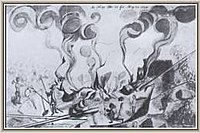
In 1719, the antiquarian William Stukeley visited the site, where he witnessed the destruction being undertaken by the local people. Between then and 1724 he visited the village and its monument six times, sometimes staying for two or three weeks at the Catherine Wheel Inn. In this time, he made meticulous plans of the site, considering it to be a "British Temple", and believing it to having been fashioned by the druids, the Iron Age priests of north-western Europe, in the year 1859 BC. He developed the idea that the two Inner Circles were a temple to the moon and to the sun respectively, and eventually came to believe that Avebury and its surrounding monuments were a landscaped portrayal of the Trinity, thereby backing up his erroneous ideas that the ancient druids had been followers of a religion very much like Christianity.[49]
Stukeley was disgusted by the destruction of the sarcen stones in the monument, and named those local farmers and builders who were responsible.[50] He remarked that "this stupendous fabric, which for some thousands of years, had brav'd the continual assaults of weather, and by the nature of it, when left to itself, like the pyramids of Egypt, would have lasted as long as the globe, hath fallen a sacrifice to the wretched ignorance and avarice of a little village unluckily plac'd within it."[51]
Stukeley published his findings and theories in a book, Abury, a Temple of the British Druids (1743), in which he intentionally falsified some of the measurements he had made of the site to better fit his theories about its design and purpose.[52] Meanwhile, the Reverend Thomas Twining had also published a book about the monument, Avebury in Wiltshire, the Remains of a Roman Work, which had been published in 1723. Whereas Stukeley claimed that Avebury and related prehistoric monuments were the creations of the druids, Twining thought that they had been constructed by the later Romans, justifying his conclusion on the fact that Roman writers like Julius Caesar and Tacitus had not referred to stone circles when discussing the Iron Age Britons, whereas Late Mediæval historians like Geoffrey of Monmouth and Henry of Huntingdon had described these megaliths in their works, and that such monuments must have therefore been constructed between the two sets of accounts.[53]
Late Modern period
By the beginning of the |Victorian period in 1837, the majority of Neolithic standing stones at Avebury had gone, having been either buried by pious locals in the 14th century or smashed up for building materials in the 17th and 18th. Meanwhile, the population of Avebury village was rapidly increasing, leading to further housing being built inside the henge. In an attempt to prevent further construction on the site, the wealthy politician and archaeologist Sir John Lubbock, who later came to be known as Lord Avebury, purchased much of the available land in the monument, and encouraged other buyers to build their houses outside rather than within the henge, in an attempt to preserve it.[54]
Following the opening of his own excavations, archaeologist Alexander Keiller decided that the best way to preserve Avebury was to purchase it in its entirety. Keiller was heir to the James Keiller and Son business and was able to use his wealth to acquire the site. He also obtained as much of the Kennet Avenue as possible and the nearby Avebury Manor, where he was to live until his death in 1955.[55]
Excavation at Avebury has been limited. In 1894 Sir Henry Meux put a trench through the bank, which gave the first indication that the earthwork was built in two phases. The site was surveyed and excavated intermittently between 1908 and 1922 by a team of workmen under the direction of Harold St George Gray. He was able to demonstrate that the Avebury builders had dug down 36 feet into the natural chalk using red deer antlers as their primary digging tool, producing a henge ditch with a 30-foot high bank around its perimeter. Gray recorded the base of the ditch as being 13 feet wide and flat, but later archaeologists have questioned his use of untrained labour to excavate the ditch and suggested that its form may have been different. Gray found few artefacts in the ditch-fill but he did recover scattered human bones, amongst which jawbones were particularly well represented. At a depth of about 6 feet, Gray found the complete skeleton of a 5-foot (2-m) tall woman.[56][57]
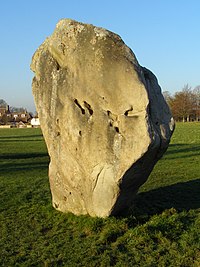
During the 1930s archaeologist Alexander Keiller re-erected many of the stones. Under one, now known as the "Barber Stone", the skeleton of a man was discovered. Coins dating from the 1320s were found with the skeleton, and the evidence suggests that the man was fatally injured when the stone fell on him whilst he was digging the hole in which it was to be buried in a mediæval "rite of destruction". As well as the coins Keiller found a pair of scissors and a lancet; the tools of a barber-surgeon at that time, hence the name given to the stone.[58][59]
When a new village school was built in 1969 there was a further opportunity to examine the site, and in 1982 an excavation to produce carbon dating material and environmental data was undertaken.
In April 2003, during preparations to straighten some of the stones, one was found to be buried at least 7 feet below ground. It was estimated to weigh more than 100 tons, making it one of the largest ever found in the United Kingdom.[60] Later that year, a geophysics survey of the southeast and northeast quadrants of the circle by the National Trust revealed at least 15 of the megaliths lying buried. The National Trust were able to identify their sizes, the direction in which they are lying, and where they fitted in the circle.[61][62]
Alexander Keiller Museum
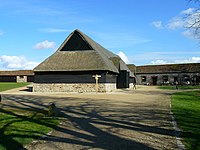
The Alexander Keiller Museum features the prehistoric artefacts collected by archaeologist and businessman Alexander Keiller, which include many artefacts found at Avebury. The museum is located in the 17th-century stables gallery, and is operated by English Heritage and the National Trust. The nearby 17th century threshing barn houses a permanent exhibit gallery about Avebury and its history.
Founded by Keiller in 1938, the collections feature artefacts mostly of Neolithic and Early Bronze Age date, with other items from the Anglo-Saxon and later periods. The museum also features the skeleton of a child nicknamed " Charlie", found in a ditch at Windmill Hill, Avebury. The Council of British Druid Orders requested that the skeleton be re-buried in 2006,[63] but in April 2010 the decision was made to keep the skeleton on public view.
The collections are owned by the Department for Culture, Media and Sport and are on loan to English Heritage.[64]
Contemporary use
Tourism
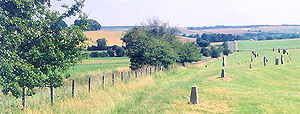
The site is a popular draw for tourists. The National Trust, who steward and protect the site, have discouraged commercialism around the site, preventing many souvenir shops from opening up in an attempt to keep the area free from the "customary gaudiness that infiltrates most famous places" in the United Kingdom.[65] Two shops have however been opened in the village catering to the tourist market, one of which is the National Trust's own shop. The other, known as The Henge Shop, focuses on selling New Age paraphernalia and books.[66]
By the late 1970s the site was being visited by around a quarter of a million visitors annually.[67]
Neo-paganism and the New Age movement
Avebury has been adopted as a sacred site by many adherents of contemporary Pagan groups which view the monument as a "living temple" which they associate with the ancestors, as well as with genius loci, or spirits of place.[68] Typically, such Pagan rites at the site are performed publicly, and attract crowds of curious visitors to witness the event, particularly on major days of Pagan celebration such as the summer solstice.[69]
Druidic rites aer helfd here frequently according to "ancient" rituals invented in the late twentieth century. Due to the fact that various pagan, and in particular Druid groups, perform their ceremonies at the site, a rota has been established, whereby the Loyal Arthurian Warband (LAW), the Secular Order of Druids (SOD) and the Glastonbury Order of Druids (GOD) use it on Saturdays, whilst the Druid Network and the British Druid Order (BDO) instead plan their events for Sundays.[70]
Alongside its usage as a sacred site amongst Pagans, the prehistoric monument has become a popular attraction for those holding New Age beliefs, with some visitors using dowsing rods around the site in the belief that they might be able to detect psychic emanations.[71]
Outside links
| ("Wikimedia Commons" has material about Avebury Stone Circle) |
- Location map: 51.42861 -1.85417
- Map: SU10266996
- Avebury information at the National Trust
- Day Out: Avebury and Marlborough – A 30-minute BBC TV programme made in 1983 of a day spent exploring Avebury and Marlborough
- National Trust information for Avebury & Alexander Keiller Museum
- Alexander Keiller Museum – English Heritage information
- Avebury – A Present from the Past Informative site about Avebury
References
- ↑ 1.0 1.1 1.2 1.3 Burl 1979. p. 30.
- ↑ National Monuments Record: No. 220746 – Avebury
- ↑ "Stonehenge, Avebury and Associated Sites". UNESCO.org. Archived from the original on 10 March 2008. http://web.archive.org/web/20080310032755/http://whc.unesco.org/en/list/373. Retrieved 27 February 2008.
- ↑ "Stonehenge, Avebury and Associated Sites". UNESCO. http://whc.unesco.org/en/list/373. Retrieved 26 July 2009.
- ↑ Malone 1989. pp. 31–32.
- ↑ Malone 1989. pp. 31, 34–35.
- ↑ #Gil04|Gillings and Pollard 2004. p 23.
- ↑ Holgate 1987.
- ↑ Gillings and Pollard 2004. pp. 23–25.
- ↑ Gillings and Pollard 2004. p. 25.
- ↑ Gillings and Pollard 2004. p. 34.
- ↑ Parker Pearson 2005. p. 57.
- ↑ Parker Pearson 2005. pp. 56–57.
- ↑ Parker Pearson 2005. pp. 58–59.
- ↑ Barrett 1994. p. 13.
- ↑ Malone 1989 p. 38.
- ↑ Parker Pearson 2005. p. 67.
- ↑ Watson 2001. p. 309.
- ↑ Gilling and Pollard 2004. p. 1.
- ↑ Pitts and Whittle 1992. p. 205.
- ↑ Malone 1989. p. 107.
- ↑ 22.0 22.1 Watson 2001. p. 304.
- ↑ Gillings and Pollard 2004. p. 07.
- ↑ "Avebury". The National Trust. The National Trust. 2009. Archived from the original on 22 June 2009. http://web.archive.org/web/20090622024806/http://www.nationaltrust.org.uk/main/w-avebury. Retrieved 16 June 2009.
- ↑ Darvill, Timothy (1996). Prehistoric Britain from the air: a study of space, time and society. Cambridge University Press. p. 185. ISBN 978-0-521-55132-8.
- ↑ Pitts & Whittle (1992), pp. 204–205.
- ↑ 27.0 27.1 Watson 2001. p. 308.
- ↑ Pollard and Gillings 1998. p. 156.
- ↑ Watson 2001. p. 300.
- ↑ Burl 1979. p. 27.
- ↑ Richards 1996. p. 206.
- ↑ Burl 1979. p. 03.
- ↑ Burl 1979. p. 07.
- ↑ Warner 1840.
- ↑ Fergusson 1872.
- ↑ Blacket 1883.
- ↑ Burl 1979. pp. 31–32.
- ↑ Burl 1979. p. 36.
- ↑ Burl 1979. pp. 36–37.
- ↑ Burl 1979. p. 37.
- ↑ Burl 1979. p. 39.
- ↑ 42.0 42.1 Burl 1979. pp. 39–40.
- ↑ Burl 1979. p. 40.
- ↑ Burl 1979. pp. 40–41.
- ↑ 45.0 45.1 Burl 1979. p. 41.
- ↑ 46.0 46.1 Burl 1979. pp. 41–43.
- ↑ Burl 1979. pp. 43–45.
- ↑ 48.0 48.1 Burl 1979. p. 46.
- ↑ Burl 1979. pp. 47–49.
- ↑ Burl 1979. p. 49.
- ↑ "The shame of Avebury". Avebury a present from the past. Archived from the original on 20 June 2009. http://web.archive.org/web/20090620164628/http://www.avebury-web.co.uk/the_shame.html. Retrieved 16 June 2009.
- ↑ Burl 1979. p. 51.
- ↑ Burl 1979. p. 51 and 57.
- ↑ Burl 1979. p. 55.
- ↑ Burl 1979. pp. 55–56.
- ↑ ditchbank
- ↑ http://www.wessexarch.co.uk/files/Learning/avebury_teachers_kit/history_of_the_avebury_monuments.pdf
- ↑ Evans (2006), p. 11.
- ↑ British Archaeology, Issue no 48, October 1999, "Lost skeleton of `barber-surgeon' found in museum" Retrieved on 16 June 2009
- ↑ "100-ton stone astounds academics". BBC News (BBC). 17 April 2003. http://news.bbc.co.uk/1/hi/england/wiltshire/2956995.stm. Retrieved 19 June 2009.
- ↑ "'Lost' Avebury stones discovered". BBC News (BBC). 2 December 2003. http://news.bbc.co.uk/1/hi/england/wiltshire/3257174.stm. Retrieved 19 June 2009.
- ↑ "Buried megaliths discovered at stone circle site". Ananova News. Ananova Ltd. Archived from the original on 12 October 2004. http://web.archive.org/web/20041012065025/http://www.ananova.com/news/story/sm_843553.html. Retrieved 19 June 2009.
- ↑ Heritage Key: Alexander Keiller Museum
- ↑ English Heritage: Alexander Keiller Museum
- ↑ Burl 1979. p. 16.
- ↑ Blain and Wallis 2007. p. 65.
- ↑ Burl 1979. p. 17.
- ↑ Blain and Wallis 2007. pp. 41 and 48.
- ↑ #Bla07|Blain and Wallis 2007. p. 55.
- ↑ Blain and Wallis 2007. p. 64.
- ↑ Burl 1979. p. 18.
Academic books
- Adkins Roy; Adkins, Lesley and Leitch, Victoria (2008). The Handbook of British Archaeology (Revised Edition). London: Constable. ISBN 978-1-84529-606-3.
- Barrett, John C. (1994). Fragments from Antiquity: An Archaeology of Social Life in Britain, 2900–1200 BC. Oxford, UK and Cambridge, USA: Blackwell. ISBN 978-0-631-18954-1.
- Blain, Jenny and Wallis, Robert (2007). Sacred Sites Contested Rites/Rights: Pagan Engagements with Archaeological Monuments. Brighton and Portland: Sussex Academic Press. ISBN 978-1-84519-130-6.
- Burl, Aubrey (1979). Prehistoric Avebury. New Haven and London: Yale University Press. ISBN 0-300-02368-5.
- Gillings, Mark and Pollard, Joshua (2004). Avebury. London: Gerald Duckworth & Co. ISBN 0-7156-3240-X.
- Hutton, Ronald (1991). The Pagan Religions of the Ancient British Isles: Their Nature and Legacy. Oxford and Cambridge, Massachusetts: Blackwell. ISBN 978-0-631-17288-8.
- Ucko, Peter, Hunter, M., Clark, A.J. and David, A. (1991). Avebury Reconsidered: from the 1660s to the 1990s. Unwin Hyman.
- Pollard, Joshua and Reynolds, Andrew (2002). Avebury: Biography of a Landscape. Stroud, Gloucestershire: The History Press. ISBN 978-0-7524-1957-2.
- Malone, Caroline (1989). Avebury. London: B.T. Batsford and English Heritage. ISBN 0-7134-5960-3.
- Parker Pearson, Michael (2005). Bronze Age Britain (Revised Edition). London: B.T. Batsford and English Heritage. ISBN 978-0-7134-8849-4.
Excavation reports
- Gillings, Mark; Pollard, Joshua; Peterson, Rick and Wheatley, David (2008). Landscape of the Megaliths: excavation and fieldwork on the Avebury monuments 1997–2003. Oxford: Oxford Bows. ISBN 978-1-84217-313-8.
- Smith, I. (1965). Windmill Hill and Avebury: Excavations by Alexander Keiller 1925–1939. Oxford: Clarendon Press.
Academic articles
- Holgate, Robin (1987). "Neolithic settlement patterns at Avebury, Wiltshire". Antiquity 61: 259–263. http://antiquity.ac.uk/ant/061/Ant0610259.htm.
- Pitts, Michael W. and Whittle, A. (1992). "Development and date of Avebury". Proceedings of the Prehistoric Society 58: 203–212.
- Pollard, Joshua and Gillings, Mark (1998). "Romancing the stones: towards a virtual and elemental Avebury". Archaeological Dialogues 5: 143–164.
- Richards, Colin, C. (1996). "Monuments as Landscape: creating the centre of the world in late Neolithic Orkney". World Archaeology 28 (2): 190–208. doi:10.1080/00438243.1996.9980340.
- Watson, Aaron, A. (2001). "Composing Avebury". World Archaeology 33 (2) (2): 296–314.
